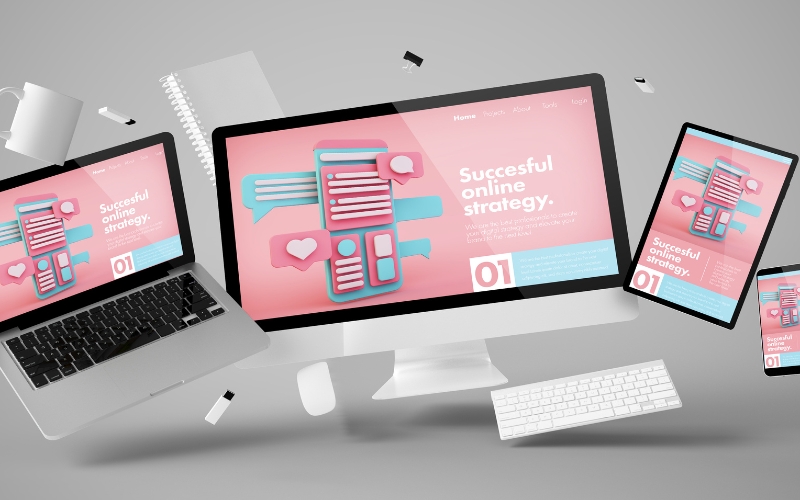
In today’s competitive online landscape, having a strong and functional website is crucial for any professional service business. One of the most important corporate website features is ensuring a seamless user experience. A website that is easy to navigate, provides valuable content, and encourages users to take the next step can help convert visitors into long-term clients. In this article, we will explore the key corporate website features that every professional service business needs to ensure optimal engagement, trust-building, and conversion.
User-Friendly Navigation: The Foundation of a Seamless Experience

One of the most essential corporate website features for any professional service business is user-friendly navigation. In today’s digital age, visitors expect to quickly find the information they need when they land on a website. If they’re forced to search endlessly or feel frustrated with complicated layouts, they are likely to leave and never return. A website’s navigation plays a pivotal role in shaping a user’s overall experience and can significantly impact engagement and conversion rates.
A clean and intuitive navigation menu is the foundation of a seamless experience for website visitors. By organizing content in a clear, logical manner, visitors can easily navigate the site without confusion. For example, creating distinct categories for services, about the company, testimonials, and contact information ensures that users can access important pages with minimal effort. This structure helps build trust and professionalism, two key factors when potential clients are deciding whether to engage with your business.
Moreover, corporate website features like a sticky or dropdown menu allow users to move through pages without scrolling back to the top of the site. This convenience leads to a better user experience by keeping navigation accessible at all times. If your site is easy to navigate, visitors are more likely to stay longer, explore multiple pages, and ultimately take action—whether it’s filling out a contact form, making a purchase, or subscribing to a newsletter.
Another important consideration for corporate website features is search functionality. A well-implemented search bar, positioned prominently at the top of the page, allows visitors to find specific content quickly without navigating through multiple sections. This is especially beneficial for websites with extensive content, such as blogs, case studies, or service portfolios. By offering this feature, you ensure that your audience can easily access the information they need, reducing the chances of them leaving due to frustration.
Additionally, mobile optimization is a crucial aspect of user-friendly navigation. Many users access websites via smartphones, so having a mobile-responsive design is necessary for a smooth experience across devices. The design should automatically adjust to various screen sizes, ensuring that menus and links remain accessible on all devices.
Responsive Design: Optimizing for All Devices and Screen Sizes

In today’s increasingly mobile-first world, one of the most important corporate website features for any professional service business is responsive design. As more and more users access websites through various devices, including desktops, tablets, and smartphones, it’s crucial to ensure that your website delivers a consistent, high-quality experience across all screen sizes. A responsive design allows your site to adapt to different devices seamlessly, providing users with an optimal viewing experience without the need for zooming or horizontal scrolling.
The primary purpose of corporate website features like responsive design is to ensure that your website looks and functions well on any device. A mobile-friendly website isn’t just a luxury—it’s a necessity. Studies show that a significant portion of web traffic comes from mobile devices, and if your site isn’t optimized for mobile users, you risk losing potential clients. A responsive design ensures that text is legible without zooming, images resize appropriately, and the layout adjusts to fit the screen size, making it easier for users to engage with your content.
For businesses that rely on online interactions—whether it’s generating leads, scheduling consultations, or making sales—having a responsive website can directly impact conversion rates. When visitors can easily navigate and interact with your site on their devices, they’re more likely to take the desired action, such as contacting your business or requesting a quote. This ease of use is a key component of building trust with your audience and improving the overall user experience.
In addition to enhancing usability, responsive design is also a factor in search engine optimization (SEO). Search engines like Google prioritize mobile-friendly websites in their rankings, meaning a well-optimized site for mobile devices can improve your visibility in search results. This makes responsive design one of the most valuable corporate website features when it comes to both user experience and SEO.
Moreover, a responsive website is easier to maintain than separate desktop and mobile versions. It ensures that all content is updated simultaneously, saving time and resources while providing a consistent brand experience. By integrating corporate website features such as flexible grids and scalable images, your website can dynamically adjust to various screen sizes and resolutions, creating a seamless experience for visitors.
Clear Call-to-Actions (CTAs): Guiding Visitors Toward the Next Step

One of the most vital corporate website features for professional service businesses is the strategic use of clear and compelling call-to-action (CTA) buttons. A well-placed CTA guides visitors toward the next step in their journey, whether it’s contacting the business, signing up for a newsletter, requesting a quote, or scheduling a consultation. CTAs serve as directional tools that lead users through the conversion funnel, making them essential for turning website visitors into engaged clients.
The effectiveness of corporate website features like CTAs hinges on their ability to be both visible and persuasive. A CTA should stand out visually but not overwhelm the page. The placement is key—CTAs need to be positioned in logical places where visitors naturally expect to take action, such as at the end of a blog post, on a service page, or after showcasing a key offering. Strategic placement increases the likelihood that users will click and engage with the business.
Moreover, the wording of the CTA is equally important. Phrases like “Request a Quote,” “Get Started Today,” or “Contact Us for More Information” should convey clear action and urgency. The language should also align with the overall goal of the website, ensuring that users know exactly what will happen when they click the button. This transparency builds trust and encourages visitors to take the desired action without hesitation.
Incorporating CTAs into your website’s design not only enhances the user experience but also directly impacts conversions. Whether a user clicks a CTA to schedule an appointment or to sign up for a service, each action brings them closer to becoming a paying client. These corporate website features help nurture leads by simplifying the process, reducing friction, and making it easy for potential clients to move forward.
Another essential consideration for CTAs is mobile optimization. As more users access websites through mobile devices, ensuring that CTAs are responsive is crucial. Buttons must be large enough to click on mobile screens and remain easily accessible no matter the device.
Compelling and Well-Structured Content: Capturing Attention and Building Trust

One of the most critical corporate website features that directly influences user engagement and conversion is high-quality, well-structured content. For professional service businesses, content is not just about filling space on a page; it’s about speaking directly to the needs and concerns of your target audience. Engaging content can establish authority, build trust, and clearly communicate the value your business provides, ultimately making visitors more likely to convert into clients.
The foundation of compelling content lies in understanding your audience and what they are seeking. Well-researched and relevant content that addresses specific pain points can make a website stand out in an increasingly crowded marketplace. Whether through blog posts, service descriptions, or client case studies, the key is to speak the language of your audience and offer insights that resonate with them. This approach not only captures attention but also encourages users to stay on your site longer, boosting engagement and reducing bounce rates—important metrics for both user experience and SEO.
Corporate website features like clear headings, bullet points, and concise paragraphs enhance the overall readability of the content. A well-structured page allows visitors to quickly scan and find the information they need. When presenting complex services, breaking down the content into digestible sections helps maintain reader interest and ensures that they can easily absorb and understand key points. This structured approach makes the content not only easier to navigate but also more likely to be shared, increasing its reach and visibility.
Beyond structure, compelling content also helps establish trust and authority. For instance, providing valuable insights, data, and real-world examples shows potential clients that your business is knowledgeable and reliable. Including testimonials, client success stories, or professional certifications as part of your content further enhances credibility. These corporate website features serve as social proof, which is crucial when clients are making decisions about which professional service business to choose.
Additionally, content that speaks directly to the needs of potential clients helps foster a deeper connection. Rather than simply listing services, the content should highlight how those services solve specific problems or deliver tangible benefits. This focus on value builds trust by showing that you understand your clients’ challenges and are committed to addressing them effectively.
SEO Best Practices: Ensuring Your Website is Visible to Potential Clients

One of the most essential corporate website features for any professional service business is robust search engine optimization (SEO). SEO is the process of optimizing your website to rank higher in search engine results, making it more likely that potential clients will find your business online. A well-optimized website is not only easier for users to navigate but also helps search engines like Google understand and rank your content appropriately. Implementing effective SEO practices ensures that your website is visible to the right audience, driving more organic traffic and ultimately increasing conversion opportunities.
A fundamental aspect of SEO is the use of relevant keywords throughout your website. By strategically incorporating keywords related to your services and industry into the content, headings, and meta tags, you signal to search engines that your website is relevant to users’ search queries. For example, if your professional service business offers web design services, using specific keywords like “corporate website design” or “professional web development” in your content will help attract visitors who are searching for these services. These targeted corporate website features increase the chances of ranking higher in search results, making your business easier to find.
In addition to keyword optimization, metadata plays a critical role in SEO. Meta titles and descriptions are what users see in search engine results, so crafting these elements carefully can impact your click-through rate (CTR). A well-written meta title includes relevant keywords, is concise, and clearly communicates what the page is about. The meta description should provide a brief, compelling overview of the page’s content, enticing users to click through to your site. These corporate website features are important because they help search engines index your content correctly while also attracting visitors to your website.
Another key SEO practice is optimizing your website’s structure. A clean, well-organized website with a logical page hierarchy and internal linking structure makes it easier for both search engines and users to navigate. Proper use of heading tags (H1, H2, etc.) to structure your content allows search engines to understand the importance of different sections on the page. This is a vital corporate website feature that not only helps with SEO but also improves user experience, encouraging visitors to explore your site further.
Conclusion:
To ensure your website remains competitive in today’s digital world, it’s essential to incorporate corporate website features that improve user experience and drive conversions. A great resource for further insights on how to optimize your website’s design and functionality is Smashing Magazine. They offer in-depth articles and guides on web design best practices, helping businesses stay up-to-date with the latest trends and technologies. Leveraging these resources can assist you in creating a website that truly meets the needs of your audience.
To sum up, incorporating essential corporate website features such as user-friendly navigation, responsive design, clear CTAs, well-structured content, and effective SEO practices is critical for driving the success of any professional service business online. A website that prioritizes ease of use, accessibility, and relevant content can engage visitors more effectively, enhance trust, and ultimately increase conversions. By focusing on these features, businesses can create a website that not only attracts potential clients but also provides them with a seamless, professional experience that leads to long-term success.
For more details or to discuss your specific Website Development and Design, visit our Website Development and Design page.

